Playism Page || Steam Page || Developer’s Site
Any major commercial release by Studio Pixel will inevitably be compared to Cave Story and Kero Blaster is certainly no exception. With its run-and-gun 2D platforming, its light RPG elements, and its retro aesthetics Kero Blaster seems to have much in common with the legendary indie game. However, these similarities are largely superficial because this is not a spiritual sequel to Cave Story, it’s not trying to be a spiritual sequel, and, to be as clear as possible, that is absolutely, perfectly fine. Kero Blaster is a linear platforming experience divided into several levels, the multiple unlockable difficulties are different enough to definitely warrant going through the game more than once, and the combat system incorporates some of the best elements from Cave Story while refining them into an incredibly polished state.
Taking on the role of a frog working for Cat & Frog Inc. in the field of custodial sciences, your assignment is to clean up the black, blobby creatures which have infected the company’s teleportation machines. Naturally, the best tools for the job are guns, a jetpack, and a warm jacket and you can expect to encounter a few dozen plants, fish, birds, moles, and other deadly forms of wildlife along the way. It’s a dangerous job, but somebody’s got to do it or else you might be stuck working mandatory overtime at the office forever.
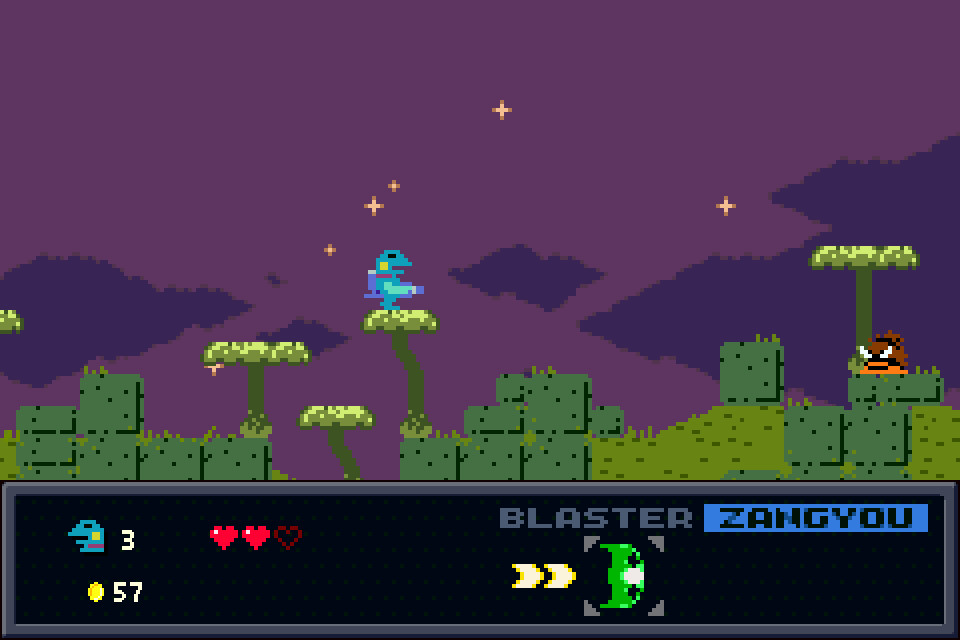
You start armed only with your blaster, a gun with a decent rate of fire, mediocre range, and terrible damage. Thankfully, this sorry state doesn’t last for long as there is an upgrade shop halfway through every level and you find a new gun at the end of levels one, two, and four as well as a jetpack in level three. On top of providing permanent upgrades for each of your four weapons, the shops allow you to refill your health and increase your maximum health (you only have two painfully fragile points of health initially) and you can buy prohibitively expensive extra lives and some more reasonably priced jars which are automatically consumed to revive you with up to four hearts if you die. Once you gain the jacket, which absorbs a hit for you before falling off, you can grab a new jacket from a coat hanger in these shops free of charge if you’ve lost it. The guns and upgrades you find along the way will have you feeling considerably more powerful by the end of Kero Blaster‘s seven levels, so let’s take a look at them.
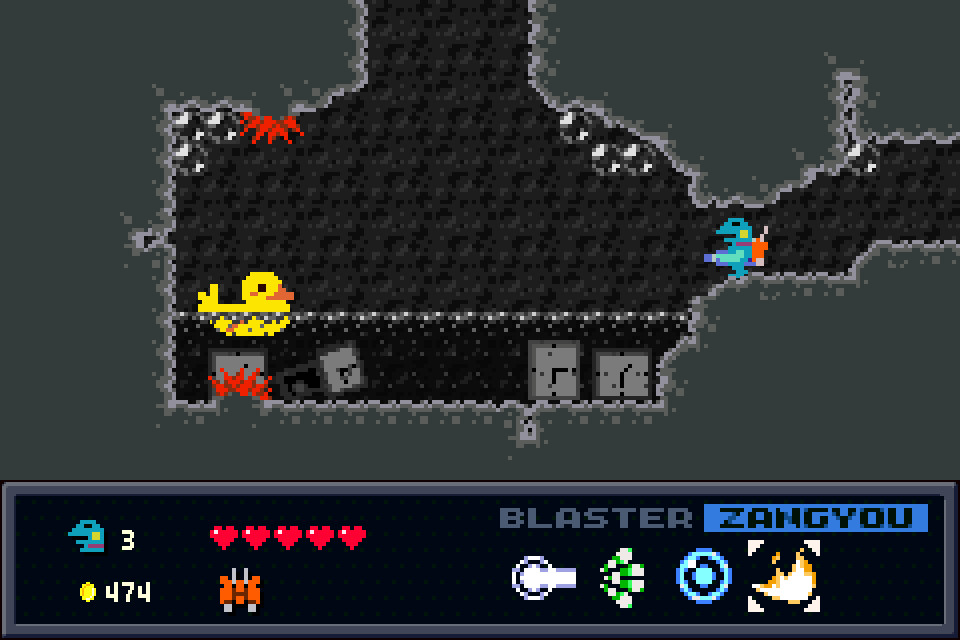
Simply put, Kero Blaster as one of the most solid weapon arsenals I’ve seen in a game. All four of the weapons are fun to use and they complement each other perfectly, especially since the levels are carefully designed to take all of them into account. Though the blaster starts off weak and it can never go far underwater, its first upgrade boosts its damage and greatly increases its range and continuing to invest in it turns it into a powerful laser with enough range to hit enemies which aren’t even on the screen. What starts off as a nearly useless weapon has the ability to become the best gun in the game for taking out bosses and other large enemies. The second gun, the fan, starts off as a trade-off to the default gun with a slower rate of fire, slightly more damage per hit, better vertical range, and the ability to shoot underwater without losing range. However, buying the second upgrade for this gun transforms it into a quadruple spread shot, making it a bit harder to hit enemies directly in front of you at long range, but granting you the ability to deal with swarms of enemies or to hit enemies at odd angles without fear of retaliation.
Next up is the bubble gun, which also appeared in Cave Story and is the most situational of the weapons. The bubble gun rapidly produces bubbles which rise to the surface in water and fall down to roll along the floor on land. Flying enemies are nearly impossible to hit with the bubble gun, but you can’t normally aim downward so this gun allows you to safely hit enemies which no other gun can easily reach and the bubbles themselves are capable of rolling down slopes and can rapidly add up for plenty of damage. Last of all, and possibly my personal favorite, is the flamethrower, which has surprisingly good range and deals continuous damage to anything its flames touch. The flamethrower can’t outpace the fully upgraded laser when it comes to raw damage, but it makes up for this with its ability to destroy frozen objects and most projectiles, a trait which makes this version of a flamethrower a surprisingly defensive weapon and as an added bonus the flames are even able to flow along gentle slopes so it still does well in uneven terrain. Between the laser’s high damage and long range, the fan’s wide spread of projectiles, the bubble gun’s ability to aim downward, and the flamethrower’s projectile-destroying defenses, you are fully equipped for taking on any challenge the game throws your way and figuring out the best gun for each situation always feels satisfying.
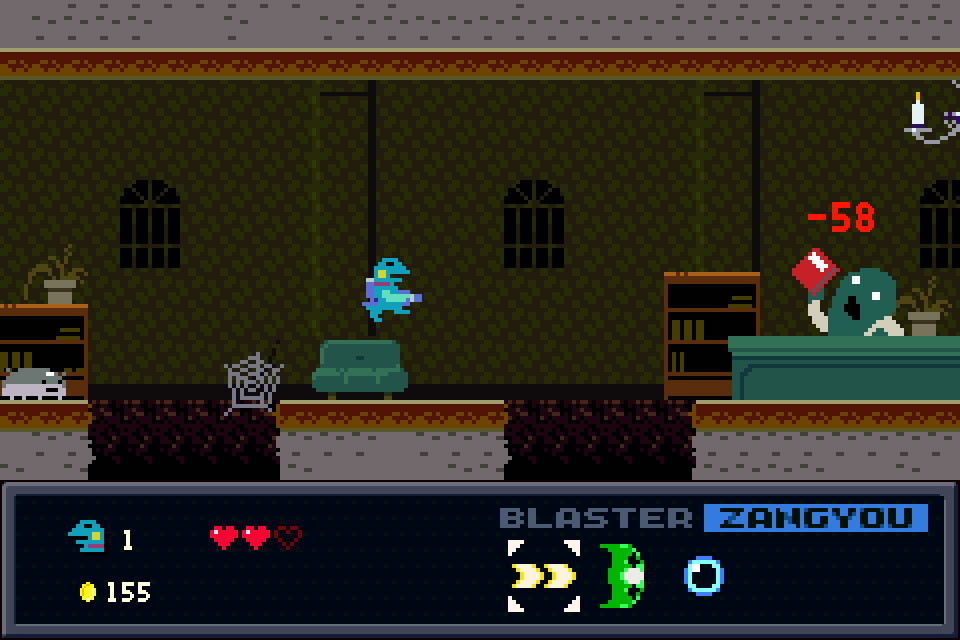
Jumping in Kero Blaster is a bit unusual and not in a bad way, though it can take some time to get used to. To begin with you get a small, but nonetheless incredibly important, about of addition vertical height if you jump straight up with absolutely no horizontal movement. Moving even a few pixels left or right while jumping will negate this boost to your jump height. While being able to jump a little higher may not sound like a big deal, the game is designed with this purely vertical jump in mind as you’ll need to use it to reach some ledges and to dodge certain hazards and boss attacks, mostly ones which are capable of crushing you for an instant-kill if you fail to dodge them.
Horizontal jumps are also strange to a degree and in a way which is difficult to explain. Basically, short jumps don’t really exist for the most part due to how momentum works while jumping. Trying to leap over a small gap is usually a bad idea because you’ll often end up either barely moving at all or jumping right into the gap itself; you simply don’t have much horizontal momentum unless you’re going for at least a medium jump. To its credit, the game never forces you to attempt small jumps (at least as far as I can recall) as even when there is a narrow gap you are given enough room on your current platform to back away from it for a bit and the introduction of a jetpack for a double jump leads to an even greater focus on tricky long jumps and high jumps. I suppose to makes perfect sense for a game where you play as a frog to emphasize large leaps and the end result is platforming which feels comfortably familiar while also feeling just different enough to be memorably unique.
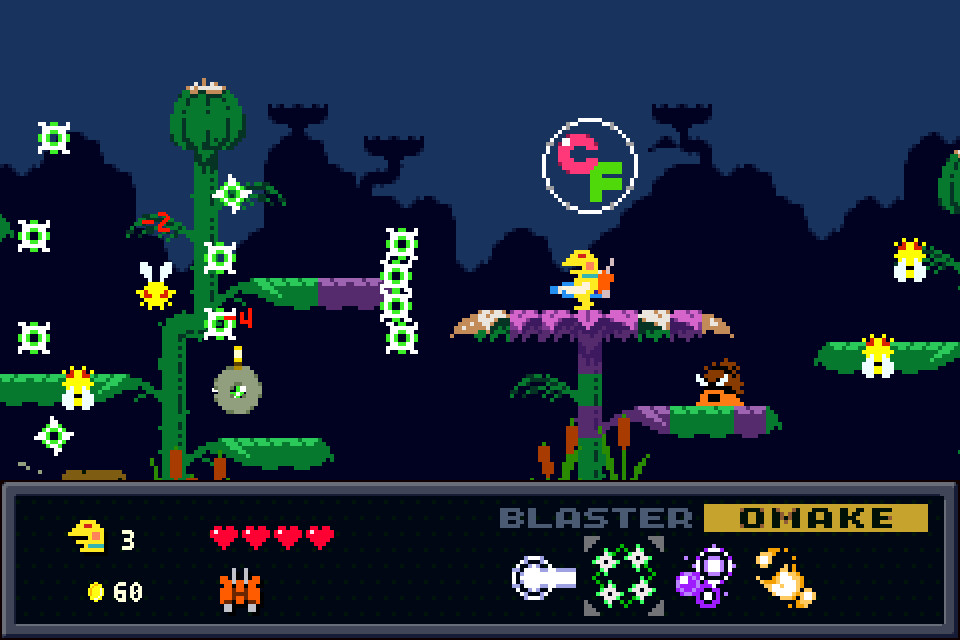
For the most part, progression is handled very well. Weapon and health upgrades start off cheap and their prices rapidly rise between upgrade tiers. However, the amount of money you can find also significantly increases between levels with enemies in the first level only ever dropping coins with a value of one and ten-value coins gradually becoming more common in the next few values until moneybags worth fifty each at last start dropping. This steady increase in both money obtained and money required means you should always have enough money for one or two upgrades each time you find a store, yet not enough to max out a weapon early on or to simply buy everything.
The life system ties into the upgrade system as you do have a limited number of lives, but running out of lives simply sends you back to the start of the current level with all of your money and purchased upgrades intact allowing for some difficulty flexibility despite the largely linear nature of the level design as long as you can reach the shop. Each level also has at least one hidden safe packed with money and there is also a midboss in each level which will drop money upon defeat to give your wallet a hefty boost, but vaults remain open and midbosses remain defeated between attempts, preventing you from getting overly excessive amounts of money while further reducing the difficulty by permanently eliminating a major threat after the first time it is overcome. You are also checkpointed at every screen transition on top of the game being saved so you are free to take a break at any time and dying never sets you back too far unless you run out of lives. The only downside to this system is that running out of lives near the end of a level can carry some degree of tedium, especially if you are stuck on a boss, and being given the option to restart at the halfway point rather than all the way back at the beginning every time would have been useful.
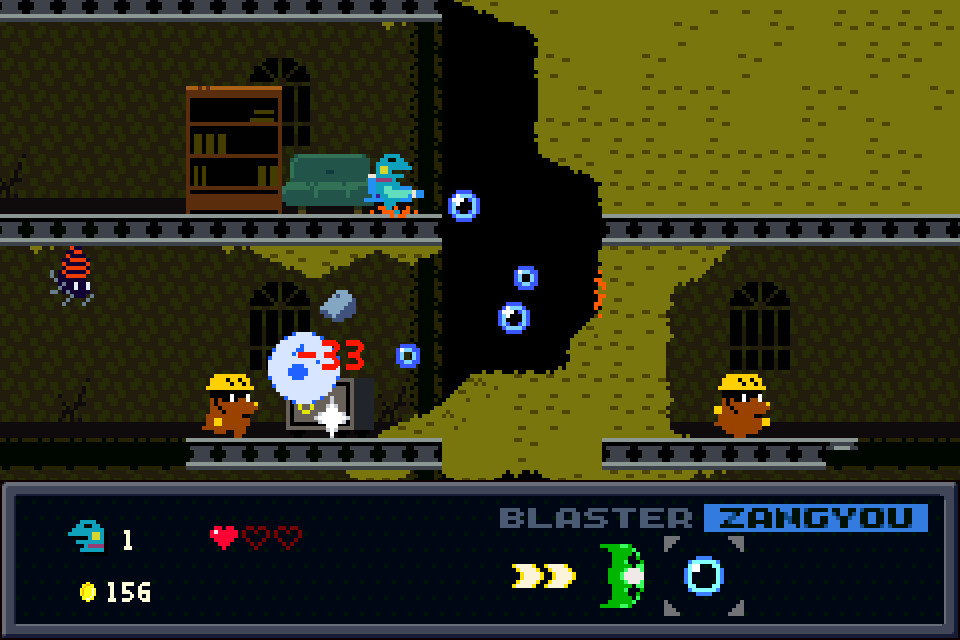
Like with any action platformer, level design is a huge factor and in this regard Kero Blaster is truly a masterpiece. Levels aren’t just aesthetically diverse, they each have a distinct feel. For example, the second level has you hopping between leaves to climb up and across giant plants in a swamp while overcoming aerial assaults from diving birds and bugs and ground-level attacks from snakes and mudmen which pop out of the dirt. Meanwhile, the third level initially has you busting down walls while you make your way through a hotel infested with bats and spiders and it soon gives way to an underground tunnel filled with mining moles and large underwater segments. Many enemy types carry over between levels, but most of the obstacles and hazards found throughout the game are unique to specific levels.
The design of each level is also crafted to encourage you to take full advantage of your most recent ability without ever forcing you to stick with a single weapon. If we go back to the previous example of level two, we can see that the freshly acquired fan works well against all the flying enemies and it can even take out the snakes and mudmen while they are still partially buried, but the original blaster still has its uses here as long as you’ve upgraded it at least once since its longer range gives it an advantage over more stationary targets and it has a much easier time hitting the boss’s weak spot. Meanwhile, the third level has you often moving downward, which makes it perfect for introducing players to the high advantage the bubble gun gives you over enemies below you and the water segments make the fan and the bubble gun equally viable options. The difficulty is also balanced well and increases at a gentle, steady pace which is always just enough to provide a good challenge without becoming frustrating. Each and every part of the level design is carefully and masterfully crafted to create a virtually flawless platforming paradise where the abilities at your disposal are always taken into account.
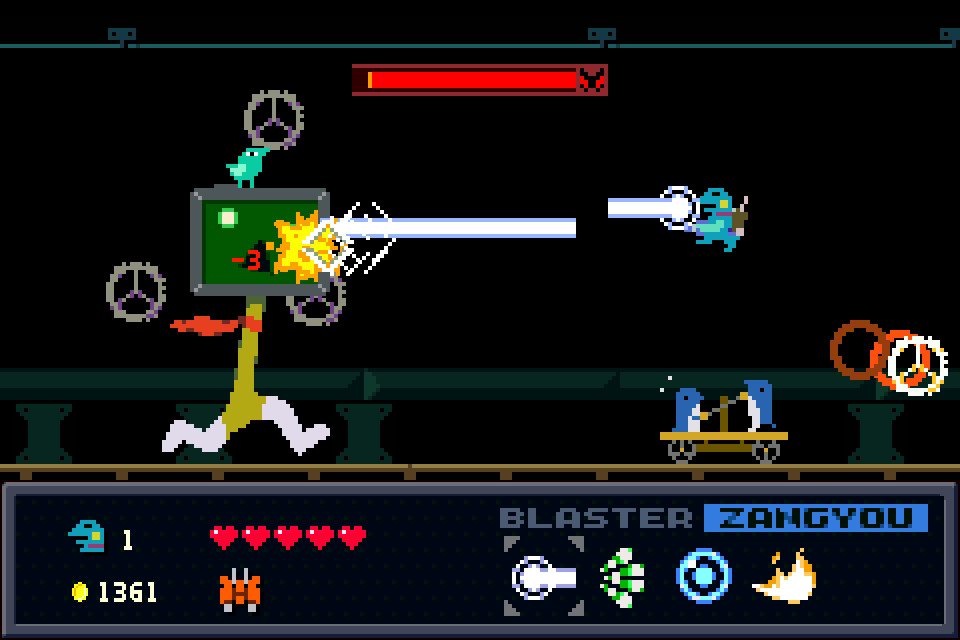
For those seeking an even greater challenge, completing the game once is only the beginning as this unlocks a new difficulty option – Zangyou Mode. Although every level aside from the final one is technically the same area as in the normal difficulty, Zangyou Mode goes far beyond simply adding in a few more enemies. An entirely new story ties this mode together as this time around a machine is literally producing and infinite supply of work in the form of spontaneously appearing books and folders and it is once against up to our protagonist to stop the machine (and get the work done) to at last be free of mandatory overtime. There are several entirely new enemy types in this mode and stronger enemies appear far earlier than their normal mode counterparts with bosses in particular getting a noticeable boost via altered arenas and/or new, more dangerous versions of their attacks. The basic skeleton of each level remains intact, but the layouts of the rooms themselves are often so heavily modified that it often feels like you are going through an entirely new level altogether. To be clear, Zangyou Mode is still just as fair and as well-designed as the original version of the game, but it is also a mode which is very much designed as an extension of the default mode when it comes to difficulty; I finished the entire game on my first try without running out of lives in the original mode yet my run through Zangyou Mode resulted in me losing all my lives on the fourth level and proceeding to run out of lives at least once on nearly every level after that. Even if you finish this mode the game has yet more to offer in the form of Omake Mode, a final difficulty setting which is rather easy, but which has a few great surprises and secrets along the way.
With its incredible level design, great weapons, and three extremely different yet consistently entertaining game modes, Kero Blaster is a fantastic action platformer which lives up to the high expectations set for it.